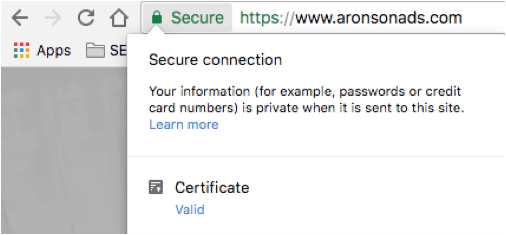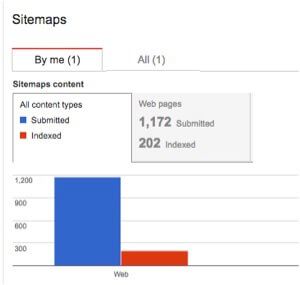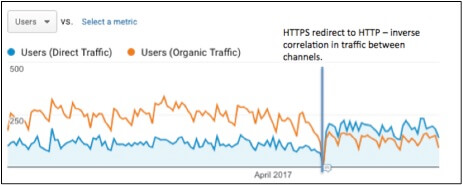
For quite some time there have been talks about securing websites to make the web a safer place for users. Going back to 2014, Google announced that they would be using HTTPs as a ranking signal and went even further in 2015 by stating they would prioritize HTTPs pages first in search rankings, but still – the transition from HTTP to HTTPs domain still was not widely adopted – until now.
There has been a significant push by search engines, especially Google, to get website owners to transition from HTTP to HTTPs URLs. As additional incentive, Google has begun showing when a website is not secure as a means of transparency and awareness for the user, and as a means to push Webmasters to make the transition.
As a Webmaster, ensuring that your website is properly transitioned to HTTPs is important. Dealing with primarily automotive dealership websites at Aronson Advertising, we have identified numerous failed deployments of the SSL certification that have lead to decreases in indexation and confusion within the search engines.
Below we highlight the two transitional oversights that we have observed impacting SEO & analytics reporting, and that maybe affecting yours.
1. XML Sitemap(s)
An XML sitemap is a file that search engines can crawl to find information about each URL on your website. It can be typically identified and implemented typically at */sitemap.xml. The information within allows search engines to better understand your website’s content and improves crawl efficiencies.
All websites should have an XML sitemap and, in some cases, may have multiple. In working with automotive CMS’s including CDK, Dealer.com & AAN, there are normally multiple XML sitemaps for various URL’s or page types. This helps keep your site clean & organized, especially for search engines.
One of the issues we found when analyzing deployments from HTTP to HTTPs pertains to the XML sitemap and the URLs housed within. Below you can see this client’s HTTPs sitemap uses HTTP URLs.
Proper protocol is to ensure that the HTTPs XML Sitemap(s) include only and all HTTPs URLs to make certain proper indexation of the HTTPs domain. Failure to do so will result in confusion for search engines and a poor index ratio as seen below.
2. Proper Redirect of HTTP to HTTPs:
Another very important aspect of the transition that often is overlooked or not done correctly is the process of 301 redirecting HTTP to HTTPs. This is a very important part of the transition and needs to be done correctly to ensure no indexation issues.
The following 301 redirects must occur when moving to HTTPs:
In reviewing many sites, we have found this to be done backwards; HTTPs gets redirected to HTTP or HTTP doesn’t get redirected at all.
This is problematic and defeats the purpose of transitioning to a secure domain. By doing this you do three things:
- Fail to move your domain in the secure direction Google and search engines are moving.
- Provide confusing signals to search engines.
- You change the landscape of your Google Analytics data.
For many, number three may be perplexing. How does a failed redirect of HTTP to HTTPs impact my data from Google Analytics? This is actually a common question that has been asked across the web – with very little information.
If a failed 301 redirect from HTTP to HTTPs occurs and is mistakenly redirected from HTTPs to HTTP, you may begin to notice the following happen to your analytics data:
- An inverse correlation of traffic patterns between Organic and Direct traffic. When this occurs you may see the following within you Analytics:
Below is analytics data showing this anomaly began to occur the same day this client had their provider move them from HTTP to HTTPs.
- Referral data may begin showing as up as ‘Direct’. When this occurs you may see:
The data issue occurred because when going from HTTPs to HTTP the referrer data becomes blocked – particularly on iOS devices. Meaning, Google Analytics is unable to properly attribute a channel to the user and assigns the user as ‘Direct Traffic’, resulting in inaccurate data.
Moving to a more secure domain is important in keeping your domain at the forefront of the SEO & digital landscape. Transitioning from HTTP to HTTPs may seem very straight forward, but can be very problematic if not done correctly. While the above outlines just two of the more significant systemic challenges through a failed SSL deployment, there are several others that we did not touch on, but that everyone should be aware of. If you do not have an individual or agency that understands the process, what to look for and how to mitigate, these missed important practices can impact SEO & your digital performance.
At Aronson, we understand the full scope of these types of transitions and the impact that it can have on your biggest digital asset. If you are looking for an automotive agency that is dedicated to quality and ensuring that you remain relevant and grow your dealerships digital presence, contact the Aronson SEO team and let’s work together to maximize visibility to both users and search engines alike.







